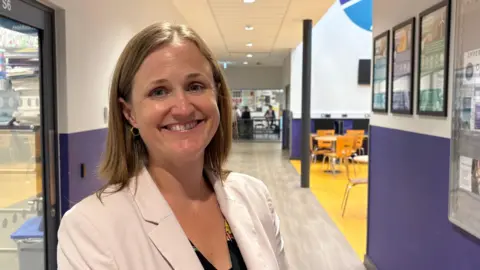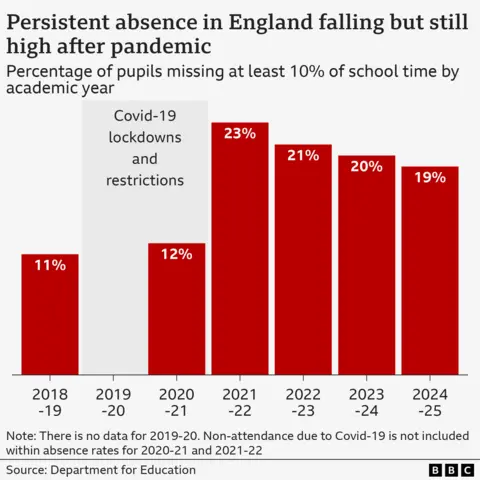Education
ChatGPT and other AI tools are changing the teaching profession

For her 6th grade honors class, math teacher Ana Sepúlveda wanted to make geometry fun. She figured her students “who live and breathe soccer” would be interested to learn how mathematical concepts apply to the sport. She asked ChatGPT for help.
Within seconds, the chatbot delivered a five-page lesson plan, even offering a theme: “Geometry is everywhere in soccer — on the field, in the ball, and even in the design of stadiums!”
It explained the place of shapes and angles on a soccer field. It suggested classroom conversation starters: Why are those shapes important to the game? It proposed a project for students to design their own soccer field or stadium using rulers and protractors.
“Using AI has been a game changer for me,” said Sepúlveda, who teaches at a dual language school in Dallas and has ChatGPT translate everything into Spanish. “It’s helping me with lesson planning, communicating with parents and increasing student engagement.”
Across the country, artificial intelligence tools are changing the teaching profession as educators use them to help write quizzes and worksheets, design lessons, assist with grading and reduce paperwork. By freeing up their time, many say the technology has made them better at their jobs.
A poll released Wednesday by Gallup and the Walton Family Foundation found 6 in 10 U.S. teachers working in K-12 public schools used AI tools for their work over the past school year, with heavier use among high school educators and early-career teachers. It surveyed more than 2,000 teachers nationwide in April.
Respondents who use AI tools weekly estimate they save them about six hours a week, suggesting the technology could help alleviate teacher burnout, said Gallup research consultant Andrea Malek Ash, who authored the report.
States are issuing guidelines for using AI tools in classrooms
As schools navigate concerns over student abuse of the technology, some are also are introducing guidelines and training for educators so teachers are aware of avoiding shortcuts that shortchange students.
About two dozen states have state-level AI guidance for schools, but the extent to which it is applied by schools and teachers is uneven, says Maya Israel, an associate professor of educational technology and computer science education at the University of Florida.
“We want to make sure that AI isn’t replacing the judgment of a teacher,” Israel said.
If teachers are using chatbots for grading they should be aware the tools are good for “low-level” grading like multiple choice tests but less effective when nuance is required. There should be a way for students to alert teachers if the grading is too harsh or inconsistent, and the final grading decision needs to remain with the educator, she said.
About 8 in 10 teachers who use AI tools say it saves them time on work tasks like making worksheets, assessments, quizzes or on administrative work. And about 6 in 10 teachers who use AI tools said they are improving the quality of their work when it comes to modifying student materials, or giving student feedback.
“AI has transformed how I teach. It’s also transformed my weekends and given me a better work-life balance,” said Mary McCarthy, a high school social studies teacher in the Houston area who has used AI tools for help with lesson plans and other tasks.
McCarthy said training she received from her school district on AI tools has helped her model proper use for her students.
“If I’m on the soapbox of, ‘AI is bad and kids are going to get dumb,’ well yeah if we don’t teach them how to use the tool,” said McCarthy. “It feels like my responsibility as the adult in the room to help them figure out how to navigate this future.”
Teachers say the technology is best used sparingly
Views on the role of artificial intelligence in education have shifted dramatically since ChatGPT launched in late 2022. Schools around the country initially banned it, but since then many have sought ways to incorporate it into classrooms. Concerns about student overuse and misuse are still prevalent: About half of teachers worry that student use of AI will decrease teens’ ability to think critically and independently or to have persistence when problem solving, according to the study.
One benefit teachers see in becoming more familiar with artificial intelligence is the ability to spot when students are overusing it.
Clues that assignments are written by AI tools include an absence of grammatical errors and complex phrases in writing, said Colorado high school English teacher Darren Barkett. He said he relies on ChatGPT himself to create lesson plans and grade multiple choice tests and essays.
In suburban Chicago, middle school art teacher Lindsay Johnson said she uses only AI programs vetted by her school and deemed safe to use with minors, for data privacy and other concerns. To ensure students feel confident in their skills, she said she brings the technology in only for later stages of projects.
For her 8th graders’ final assessment, Johnson asked them to make a portrait of an influential person in their lives. After students put final touches on their subject’s face, Johnson introduced generative AI for those who wanted help designing the background. She used an AI tool within Canva, after checking with her district’s IT department that the design software passed its privacy screener.
“As an art teacher my goal is to let them know the different tools that are out there and to teach them how those tools work,” she said. Some students weren’t interested in the help. “Half the class said, ‘I’ve got a vision, and am going to keep going with it.’”
___
The Associated Press’ education coverage receives financial support from multiple private foundations. AP is solely responsible for all content. Find AP’s standards for working with philanthropies, a list of supporters and funded coverage areas at AP.org.
Education
‘I regret pushing my daughter into school until she broke’

Ben SchofieldPolitics correspondent, BBC East
 Ben Schofield/BBC
Ben Schofield/BBCThe start of the school year saw the Education Secretary Bridget Phillipson warn parents about the need for children to attend classes.
Data suggests half of pupils who missed lessons in the first week of term last year went on to become persistently absent.
But school leaders say they are seeing more children who find attending school too traumatic.
What is it like having a child with what psychologists call emotionally based school avoidance and what should be done to help?
 Family handout
Family handoutThe final time Julie took her daughter to school in July 2023, a member of staff congratulated her.
Rosie, who was then eight, was “wearing a dirty pyjama top, a pair of jogging bottoms, a pair of trainers with no socks, she had her headphones on, she was holding a teddy”, Julie recalls.
“I walked into school and the [special needs co-ordinator] then said to me ‘well done, you got her here’.”
But for Julie, 48, it was not a “win”.
“She couldn’t even speak, she hadn’t eaten, she had maybe three or four hours sleep.
“But I’d done a good job as a parent for making her go to school?”
 Family handout
Family handoutAt the time Rosie, who has autism, was in Year Three at a primary school in Northamptonshire.
Julie says her daughter had struggled with the school environment since her time in nursery and is now educated out of school.
Rosie, she recalls, was “in fight and flight the whole time” she was in the classroom, which “just overwhelmed her”.
Eventually Rosie was “begging not to leave” the house for school and was self-harming, sometimes on the school run.
“She would have night terrors – she would be up screaming, if she went to sleep at all.
“It just felt as if I was walking her into the lion’s den every single day,” she says.
Meanwhile, Julie and her husband James received letters and home visits from school staff about Rosie’s attendance.
“It was very lonely.
“All of a sudden there’s these letters and people are talking about fines and I was lost.”
On that final say Julie says she “dragged” Rosie to school because “that was the expectation”.
Now she wishes she had taken Rosie out of school earlier.
“But I also feel that if I hadn’t have got to the point… where she broke, I would never have known if it had worked,” she says.
 Ben Schofield/BBC
Ben Schofield/BBCBased on Rosie’s reaction to school, an educational psychologist who assessed her noted she had “emotionally based school avoidance” or EBSA, a condition school leaders say they are encountering more.
Anna Hewes, the head teacher of Prince William School, a 1,400-pupil secondary in Oundle, Northamptonshire, says schools are seeing a “big increase” in EBSA among pupils in Year Seven, Eight and Nine.
The transition to secondary school is, she adds, a “key time” and at the start of the school year EBSA is “at the forefront of our minds because of the new year sevens coming through”.
The “noises, the bustling nature of a school – the busyness, all the classes walking around” make it a “real challenge” for those with sensory needs, she says.
But more generally “it’s very tough to be a teenager these days”.
Smartphones and social media, she adds, mean “young people can’t escape anymore”.
“It definitely is a post-Covid spike and these young people are genuinely really struggling to step over the threshold of the school and sometimes leave their bedrooms.”
 DJ McLaren/BBC
DJ McLaren/BBCAcross England, rates of “persistent absence” – when pupils miss 10% or more of lessons – have remained high since the pandemic.
Last academic year almost 19% of pupils were persistently absent, compared with 11% in 2018/19.
Mrs Hewes says EBSA is a “significant part” of the issue.
A lack of reliable data, however, means it is difficult to know how big a part.

Mrs Hewes says Prince William Academy prioritises “inclusion” and has recruited an assistant head teacher for “belonging”.
It has also opened a specialist “school-within-a-school” for pupils with EBSA, funded by North Northamptonshire Council. Four students have been enrolled so far and by 2028 it expects to see 48.
Jenny Nimmo, the head of inclusion at East Midlands Academy Trust, which runs Prince William Academy, says the unit will have more “homely” classrooms and on-site mental health provision.
She hopes it will be “future proof” because EBSA “isn’t going away”.
There are, she adds, “more and more young people” with “emotionally based school avoidance and indeed anxiety”.
 Ben Schofield/BBC
Ben Schofield/BBCThe Compass Centre in Luton also help pupils with EBSA access education.
Dr Joanne Summers, Luton Borough Council’s principal educational psychologist, says the condition can appear suddenly but “when you look back, there has been anxiety around being in school” and one incident might be a “catalyst”.
Intervening early, she adds, is important, as falling behind on school work and losing contact with friends can make anxiety worse.
Dr Summers says Luton has been trying to move away from seeing school absences as “defiance and truancy”.
“We are being curious about what’s going on for that young person, why is it that they are behaving in this way,” she adds.
 Ben Schofield/BBC
Ben Schofield/BBCGeoff Barton, a former head teacher in Suffolk and previous general secretary of the Association of School and College Leaders, says there should be more “emphasis on the humanity of our schools” rather than “draconian discipline” over absences.
He is researching special educational needs (Send) provision for the left-leaning think tank the Institute for Public Policy Research.
He says the people he is speaking to are “universally saying” that anxiety among pupils has increased.
But the “age of anxiety” is only one reason for persistent absence.
Another is poverty, while he says there is also a “long shadow in education of Covid” when “schools started to feel a bit more of an optional decision”.
Cornelia Andrecut, the executive director of children’s services for North Northamptonshire Council, said the authority has offered training courses for schools to learn strategies to support children with EBSA.
The government says it will spend £740m creating “more specialist places in mainstream schools” and placing Send leads in 1,000 new family hubs.
A Department for Education spokesperson says: “Schools should take a ‘support first’ approach for children who are facing barriers to regular school attendance, and we are expanding access to mental health support teams in all schools, ensuring that every pupil has access to early support services in their community.”
 Family handout
Family handoutFor Julie, taking Rosie out of school was “not a lifestyle choice” but was prompted by “trauma and distress” that her daughter is still recovering from.
Does she regret pushing Rosie to attend school?
“Yeah – definitely.
“I always wonder if there was a bit of trust broken between us as mum and daughter when I still took her into that place when it was that bad.”
Education
Earl Richardson, who spotlighted HBCU funding disparities, dies : NPR

Earl Richardson was the president of Morgan State University between 1984 and 2010.
Morgan State University
hide caption
toggle caption
Morgan State University
Earl Richardson was a Black college president — “armed with history,” as a colleague described him — when he led a 15-year-long lawsuit that ended in a historic settlement for four Black schools in Maryland and put a spotlight on funding disparities for all of the nation’s historically Black colleges and universities (HBCUs).
Richardson’s death, at 81, was announced on Saturday by Morgan State University, located in Baltimore, where he served as president when he helped organize the lawsuit that began in 2006. It was settled in 2021 when the state of Maryland agreed to give $577 million in supplemental funding over 10 years to four HBCUs.
Richardson led Morgan State from 1984 to 2010 and he had long chafed at stretching the little funding he got from the state. In the lawsuit, plaintiffs argued that Maryland had historically underfunded its Black colleges and had put them at a disadvantage by starting and boosting similar programs at nearby majority-white schools.
David Burton, one of the plaintiffs, told NPR that the case was compared to Brown v. Board of Education, the landmark lawsuit that brought up similar issues of disparities in educational opportunities for Black students, but the Maryland case raised the issues for students in higher education.
In 1990, when Richardson was a new school president, students took over the administration building for six days to protest the school’s dilapidated classrooms and dorms, with roofs that leaked and science labs stocked with outdated equipment.
Edwin Johnson was one of those student protesters. “We originally were protesting against Morgan’s administration,” including Richardson, he said. “But then after we dig and do a little research, we find out it’s not our administration, but it’s the governor down in Annapolis that isn’t equipping the administration with what they need to appropriately run the school.”
The protest ended when the students marched 34 miles to Annapolis to demand a meeting with the governor.
Richardson, who spoke of taking part in civil rights demonstrations when he was in school, had subtly guided the students to the correct target, said Johnson, who is now the university’s historian and special assistant to the provost.
That protest helped pave the way to the future, historic lawsuit.
Because Richardson was the university’s president, and an employee of the state, he couldn’t sue the state. So, a coalition of students and former students was created, the Coalition for Equity and Excellence in Maryland Higher Education Inc., to serve as the plaintiff.
Still, Richardson was the visionary behind the lawsuit, said Burton, a Morgan State alumnus and now a strategic planner for businesses. “He was armed with history,” Burton said.
“Dr. Richardson knew where the skeletons were,” Burton added. He was “a force that the state could not reckon with because of his institutional knowledge.”
At one point, during the trial, state attorneys objected to Richardson’s presence in the courtroom and asked the judge to make him leave, even though he had a right to be there as an expert witness, said Jon Greenbaum, then the chief counsel of the Lawyer’s Committee for Civil Rights Under Law, who helped argue the lawsuit.
Richardson stayed in the courtroom and “because this was really a desegregation case,” said Greenbaum, he provided historical detail that became critical to the arguments made by the lawyers representing the plaintiffs.
The funding that resulted, and Richardson’s leadership, jump-started what is now called on campus “Morgan’s Renaissance.” Or sometimes, said Johnson: “Richardson’s Renaissance” — because during Richardson’s presidency, enrollment doubled, the campus expanded with new buildings and new schools were added, including a school of architecture and a school of social work.
Richardson’s work put a spotlight, too, on the funding disparities faced by HBCUs across the country. They are more likely than other schools to rely upon federal, state and local funding — money that has faced budget cuts in recent years. Compared to other universities and colleges, HBCUs get a higher percentage of their revenue from tuition and less from private gifts and grants, according to one study.
In testimony before the U.S. House of Representatives in 2008, Richardson emphasized the mission of HBCUs when he told lawmakers that Black schools like his educated the most talented Black students but also sought to attract students who didn’t consider, or thought they couldn’t afford, to go to college. “We can make them the scientists and the engineers and the teachers and the professors — all of those things,” he said. But only if “we can have our institutions develop to a level of comparability and parity so that we are as competitive as other institutions.”
Education
How millions of dollars in funding cuts will impact Hispanic Serving Institutions
Chancellor Sonya Christian of the California Community College system talks about the impact of funding cuts for students.
-

 Business2 weeks ago
Business2 weeks agoThe Guardian view on Trump and the Fed: independence is no substitute for accountability | Editorial
-
Tools & Platforms1 month ago
Building Trust in Military AI Starts with Opening the Black Box – War on the Rocks
-

 Ethics & Policy2 months ago
Ethics & Policy2 months agoSDAIA Supports Saudi Arabia’s Leadership in Shaping Global AI Ethics, Policy, and Research – وكالة الأنباء السعودية
-

 Events & Conferences4 months ago
Events & Conferences4 months agoJourney to 1000 models: Scaling Instagram’s recommendation system
-

 Jobs & Careers3 months ago
Jobs & Careers3 months agoMumbai-based Perplexity Alternative Has 60k+ Users Without Funding
-

 Podcasts & Talks2 months ago
Podcasts & Talks2 months agoHappy 4th of July! 🎆 Made with Veo 3 in Gemini
-

 Education2 months ago
Education2 months agoMacron says UK and France have duty to tackle illegal migration ‘with humanity, solidarity and firmness’ – UK politics live | Politics
-

 Education2 months ago
Education2 months agoVEX Robotics launches AI-powered classroom robotics system
-

 Podcasts & Talks2 months ago
Podcasts & Talks2 months agoOpenAI 🤝 @teamganassi
-

 Funding & Business3 months ago
Funding & Business3 months agoKayak and Expedia race to build AI travel agents that turn social posts into itineraries




















